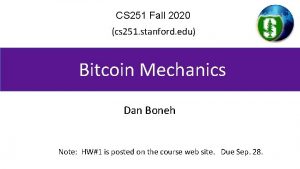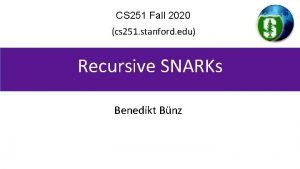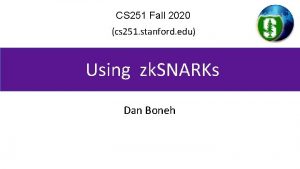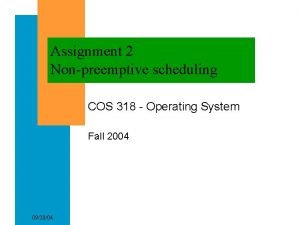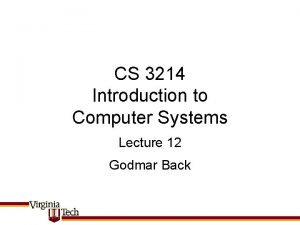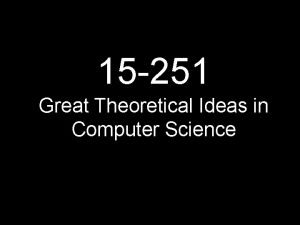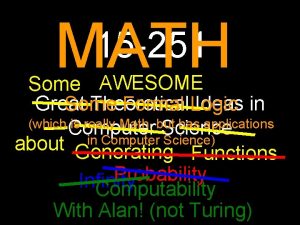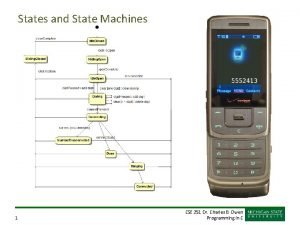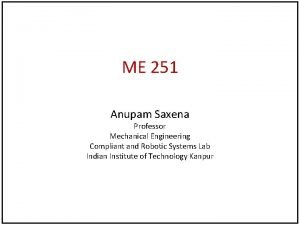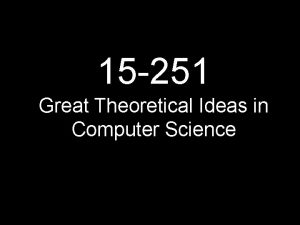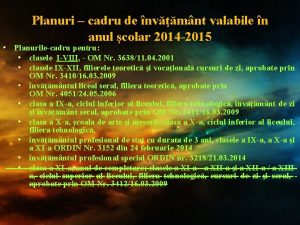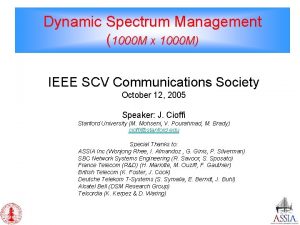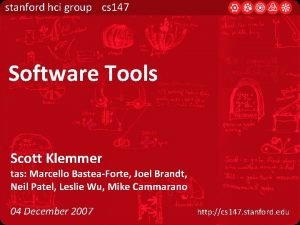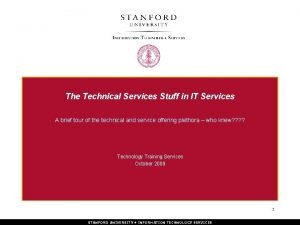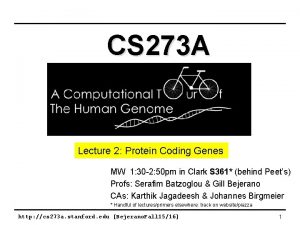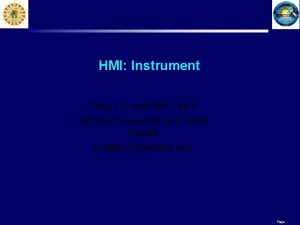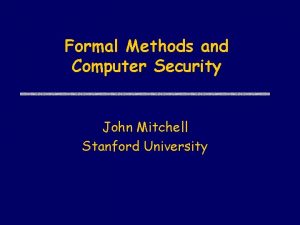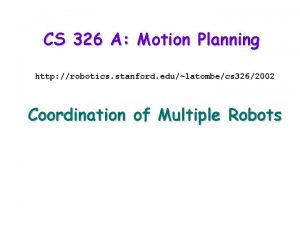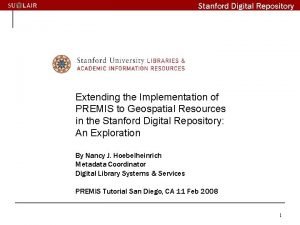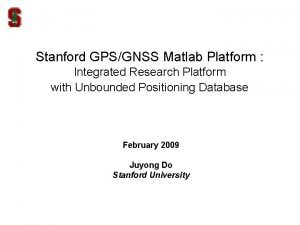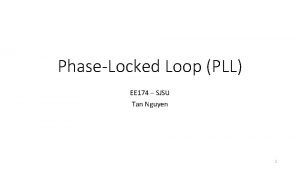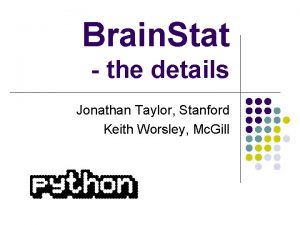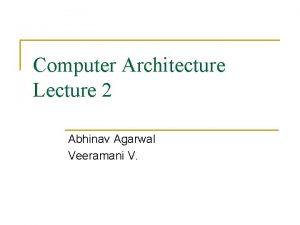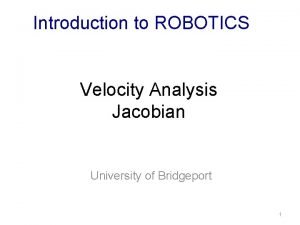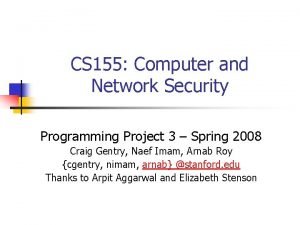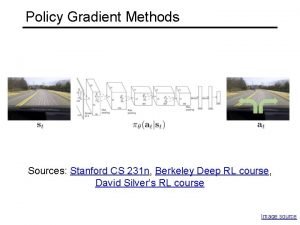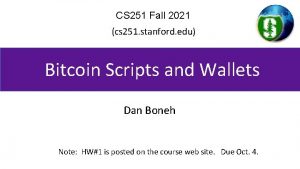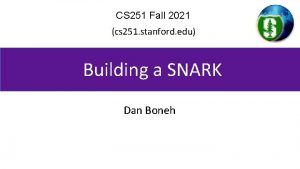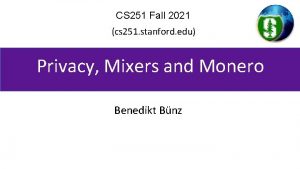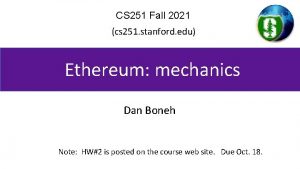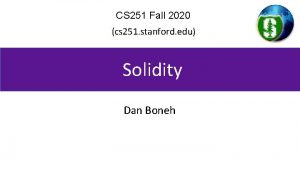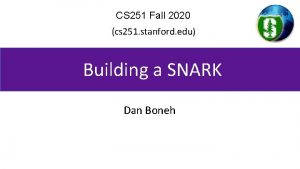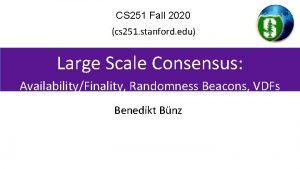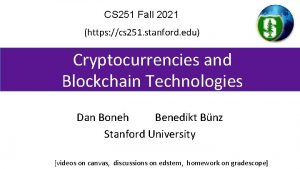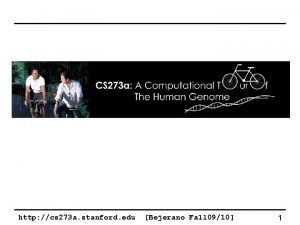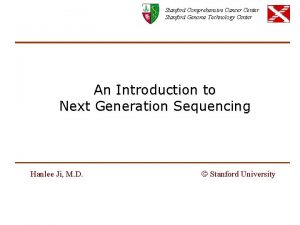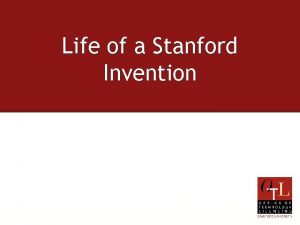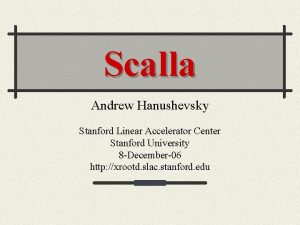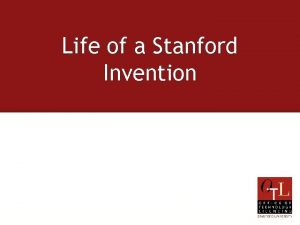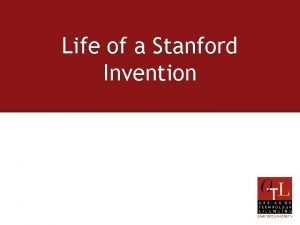CS 251 Fall 2021 cs 251 stanford edu








































![Properties: signature aggregation [BGLS’ 03] Anyone can compress n signatures into one Verify( pk Properties: signature aggregation [BGLS’ 03] Anyone can compress n signatures into one Verify( pk](https://slidetodoc.com/presentation_image_h2/3d80cff24f7a45dc61c5ab057e6424b4/image-41.jpg)

















- Slides: 58

CS 251 Fall 2021 (cs 251. stanford. edu) Final Topics Dan Boneh Invited talk final lecture. Final exam will be released this week.

Quick Recap: zk. Rollup rollup server L 1 blockchain (e. g. Ethereum) atomic swap: [B�Z: 1 ETH] [Z�B: 2 BAT] root block 354 Merkle Tree Tx Alice: 5 DAI 3 ETH Bob: 2 ETH … Zoe: 1 ETH 3 BAT

Quick Recap: zk. Rollup rollup server L 1 blockchain (verifies SNARK) atomic swap: [B�Z: 1 ETH] [Z�B: 2 BAT] Tx new root Tx data , SNA RK Merkle Tree Alice: 5 DAI 1 ETH Bob: 3 ETH 2 BAT … Zoe: 2 ETH 1 BAT block 354 block 357

Key points The Rollup server stores all account balances • L 1 chain does not store explicit balances Rollup: Tx data written to L 1 chain (16 gas per byte) Validium: Tx data written to off-chain staked servers (cheaper) why store Tx data? … backup in case rollup server fails Can we hide Tx data from the Rollup server and the public? • Yes! Using (zk)2 -SNARKs

A brief discussion of NFTs

NFTs: managing digital assets Example digital assets: (ERC-721) • Digital art: opensea, foundation • Collector items: NBA top shots • Game items: horses (zed. run), axies, … • Metaverse: ENS, plots in a virtual land #8857 Why manage on a blockchain? Why not manage centrally? • Blockchain ensures long-term ownership, until sale. • Provides a trusted record of provenance (forgeries are evident) NBA

Example: Crypto. Punks 10, 000 total Crypto. Punks on Ethereum. Generated in 2017. all offers and sales recorded on Ethereum (250 lines of Solidity) visa #7610 buy offer sold! sell offer https: //www. larvalabs. com/cryptopunks/details/7610

The resulting gas wars Gas prices spike around highly-anticipated NFT launches: … maybe don’t use first come first serve? ? Base fee gas Sep. 2021 https: //www. paradigm. xyz/2021/10/a-guide-to-designing-effective-nft-launches/

digital assets: where is this going? NFTs are about managing ownership of general digital assets Growing list of categories on Open. Sea What does ownership mean: • Where is item stored? • Where can it be displayed? • Who receives royalties on item: owner or creator?

digital assets: where is this going? NFTs and De. Fi: asset-based De. Fi: • Use NFT as collateral in loans (e. g. , nftfi. com) • Fractional ownership of NFT assets (e. g. , fractional. art) • NFT-based futures market … all require a way to appraise an NFT (e. g. , upshot. io)

Many more topics to cover

Many more topics to cover … (1) Maximal extractable value (MEV): • Recall: Ethereum v 1 � all Tx enter a public mempool • Example MEV problem: Tx Tx Tx: credit Bob gas. Price: X mempool Tx’: credit Alice gas. Price: 2 X mempool (i) Trader Bob finds a liquidation opportunity on Compound, (ii) Alice scans mempool, finds Bob’s Tx, (iii) Alice issues Tx’ with higher gas. Price, scheduled first, and takes Bob’s profit automated fontrunners �do this automatically

Many more topics to cover … (1) Maximal extractable value (MEV): • Recall: Ethereum v 1 � all Tx enter a public mempool • Example MEV problem: Tx Tx Tx: credit Bob gas. Price: X mempool Tx: credit Alice gas. Price: 2 X mempool Miner’s revenues increase (MEV). Who gets hurt? • Bob. Leads to high gas prices on Ethereum, and other bad effects What to do? Several answers: see, e. g. , flashbots (mev-geth)

Many more topics to cover … (1) Maximal extractable value (MEV) (2) On-chain Governance: • How to decide on updates to Uniswap, Compound, … ? ? ? • Current method: • Interested parties can buy governance tokens • One token one vote • Better mechanisms?

Example: Uniswap proposals

Many more topics to cover … (1) Maximal extractable value (MEV) (2) Project governance: • How to decide on updates to Uniswap, Compound, … ? ? ? (3) Insurance: against bugs in Dapp code and other hacks (4) Many more cute cryptography techniques (see slides at end) (5) Interoperability between blockchains … discussed next

More topics … • Where can I learn more? • CS 255 and CS 355: Cryptography • EE 374: Scaling blockchains with fast consensus • Stanford blockchain conference (SBC): Jan. 24 -26, 2022. • Stanford blockchain club Discussion: a career in blockchains? Where to start?

Bridging blockchains

Many L 1 blockchains Bitcoin: Bitcoin scripting language (with Taproot) Ethereum: EVM. Currently: expensive Tx fees (better in Eth 2) EVM compatible blockchains: Celo, Avalanche, BSC, … • Higher Tx rate � lower Tx fees • EVM compatibility �easy project migration and user support Other fast non-EVM blockchains: Solana, Flow, Algorand, … • Higher Tx rate � lower Tx fees

The problem: siloes Flow Solana Ethereum Serum DEX Can I use Serum? ? Bitcoin How? ? ? Polkadot 20 DOT

Interoperability: • User owns funds or assets (NFTs) on one blockchain system Goal: enable user to move assets to another chain Composability: • Enable a DAPP on one chain to call a DAPP on another Both are easy if the entire world used Ethereum • In reality: many blockchain systems that need to interoperate • The solution: bridges

A first example: BTC in Ethereum How to move BTC to Ethereum ? ? Goal: enable BTC in De. Fi. �need new ERC 20 on Ethereum pegged to BTC (e. g. , use it for providing liquidity in De. Fi projects) The solution: wrapped coins • Asset X on one chain appear as wrapped-X on another chain • For BTC: several solutions (e. g. , w. BTC, t. BTC)

w. BTC and t. BTC: a lock-and-mint bridge Let’s start with w. BTC: Alice 1� 1� 1� (lock 1 BTC) moving 1 BTC to Ethereum 1�verified (signed) custodian’s BTC address (watch for deposits) mint 1 w. BTC ERC 20 Alice on Ethereum credit Alice’s address bridge contract 1 w. BTC to use in De. Fi custodian

Alice wants her 1 BTC back Moving 1 w. BTC back to the Bitcoin network: Alice deduct 1 w. BTC from Alice 1� 1� 1� (1 BTC unlocked) Bitcoin Tx (signed) custodian’s BTC address burn my 1 w. BTC (signed) bridge contract (watch for burns) custodian Alice on Ethereum

w. BTC Example BTC �Ethereum: (Bitcoin Tx: ≈4, 000 BTC) (Ethereum Tx: ) Why two hours? … make sure no Bitcoin re-org Nov. 2021 The problem: trusted custodian Can we do better?

t. BTC: no single point of trust Alice requests to mint t. BTC: random three registered custodians are selected and they generate P 2 PKH Bitcoin address for Alice signing key is 3 -out-of-3 secret shared among three (all three must cooperate to sign a Tx) Alice sends BTC to P 2 PKH address, and received t. BTC. Custodians must lock 1. 5 x ETH stake for the BTC they manage • If locked BTC is lost, Alice can claim staked ETH on Ethereum.

Bridging smart chains (with Dapp support) A very active area: • Many super interesting ideas https: //medium. com/1 kxnetwork/blockchain-bridges-5 db 6 afac 44 f 8

Two types of bridges Type 1: a lock-and-mint bridge • SRC �DEST: user locks funds on SRC side, wrapped tokens are minted on the DEST side • DEST �SRC: funds are burned on the DEST side, and released from lock on the SRC Side Type 2: a liquidity pool bridge • Liquidity providers provide liquidity on both sides • SRC �DEST: user sends funds on SRC side, equivalent amount released from pool on DEST side

Bridging smart chains (with Dapp support) Step 1 (hard): a secure cross-chain messaging system Source Chain S DAPP-X message to Y on chain T: data relayer (contract) message from X on chain S: data relayer (contract) I believe it Target Chain T DAPP-Y Step 2 (easier): build a bridge using messaging system

Bridging smart chains (with Dapp support) Step 1 (hard): a secure cross-chain messaging system Source Chain S DAPP-X DAPP-Y Target Chain T Step 2 (easier): build a bridge using messaging system • DAPP-X �DAPP-Y: “I received 3 CELO, ok to mint 3 w. CELO” • DAPP-Y �DAPP-X: “I burned 3 w. CELO, ok to release 3 CELO” If messaging system is secure, no one can steal locked funds at S

Primarily two types of messaging systems (1) Externally verified: external parties verify message on chain S collect msgs D[] Source Chain S relayer. S verify sig and dispatch to recipients Relayer on S received messages D[] (signed) Target relayer. T Chain T Trustees (watch relayer. S) Relayer. T dispatches only if all trustees signed � if DAPP-Y trusts trustees, it knows DAPP-X sent message

Primarily two types of messaging systems (1) Externally verified: external parties verify message on chain S collect msgs D[] Source Chain S relayer. S verify sig and dispatch to recipients Relayer on S received messages D[] (signed) Target relayer. T Chain T Trustees (watch relayer. S) What if trustees sign and post a fake message to relayer. T? • off-chain party can send trustee’s signature to relayer. S �trustee slashed

Primarily two types of messaging systems (2) On-chain verified: chain T verifies block header of chain S receive msgs Source Chain S relayer. S send messages D[] to relayer. T, along with finalized block header on chain S, and Merkle proofs verify and dispatch relayer. T Target Chain T oracle relayer. T runs a (light) client for chain S to verify that relayer. S received messages D[] no trustees

Primarily two types of messaging systems receive msgs Source Chain S relayer. S SNARK prover msgs D[], BH, S NARK block header (BH) and Merkle proofs verify SNARK proof and dispatch Target relayer. T Chain T oracle Problem: high gas costs on chain T to verify state of source chain. Solution: use SNARKs �little work for relayer. T

Bridging: the future vision User can hold assets on any chain • Assets move cheaply and quickly from chain to chain • A project’s liquidity is available on all chains • Users and projects choose the chain that is best suited for their application and asset type We are not there yet …

Fun crypto tricks

BLS signatures one Bitcoin block Tx 1: inputs outputs sigsig Tx 2: sig Tx 3: sig Tx 4: sigsig sig sigsig Signatures make up most of Tx data. Can we compress signatures? • Yes: aggregation! • not possible for ECDSA

BLS Signatures Used in modern blockchains: Ehtereum 2. 0, Dfinity, Chia, etc. The setup: • G = {1, g, …, gq-1} a cyclic group of prime order q • H: M × G �G a hash function (e. g. , based on SHA 256)

BLS Signatures •

How does verify work? • verify test = =
![Properties signature aggregation BGLS 03 Anyone can compress n signatures into one Verify pk Properties: signature aggregation [BGLS’ 03] Anyone can compress n signatures into one Verify( pk](https://slidetodoc.com/presentation_image_h2/3d80cff24f7a45dc61c5ab057e6424b4/image-41.jpg)
Properties: signature aggregation [BGLS’ 03] Anyone can compress n signatures into one Verify( pk , m , σ* ) = “accept” pk 1 , m 1 �σ1 ⋮ aggregate pkn , mn �σn single short signature � σ* convinces verifier that for i=1, …, n: user i signed msg mi

Aggregation: how user 1: pk 1 = gα 1 , m 1 � σ1=H(m 1, pk 1)α 1 σ �σ1⋯ σn user n: pkn = gαn , mn � σn=H(mn, pkn)αn αi (incomplete) = = Verifying an aggregate signature: αi i=1 e(H(mi, pki) , g) = e( i=1 H(mi, pki) , g)

Compressing the blockchain with BLS one Bitcoin block Tx 1: inputs outputs sigsig Tx 2: sig Tx 3: Tx 4: sig sig sigsig sig* if needed: compress all signatures in a block into a single aggregate signatures ⇒ shrink block or: aggregate in smaller batches

Reducing Miner State

UTXO set size ≈70 M UTXOs Miners need to keep all UTXOs in memory to validate Txs Can we do better?

Recall: polynomial commitments •

Homomorphic polynomial commitment •

Committing to a set (of UTXOs) • (accumulator)

How does this help? Miners maintain two commitments: (i) commitment to set T of all UTXOs (ii) commitment to set S of spent TXOs ≤ 1 KB com. T, com. S Tx processing: miners check eval proofs, and if valid, add inputs to set S and outputs to set T. That’s it!

Does this work ? ? • polynomials S and T The proof factory

Is this practical? Not quite … • Problem: the factory’s work per proof is linear in the number of UTXOs ever created • Many variations on this design: • can reduce factory’s work to log 2(# current UTXOs) per proof • Factory’s memory is linear in (# current UTXOs) End result: outsource memory requirements to a small number of 3 rd party service providers

Taproot: semi-private scripts in Bitcoin

Taproot is here …

Script privacy Currently: Bitcoin scripts must be fully revealed in spending Tx Can we keep the script secret? Answer: Yes, easily! when all goes well …

How? •

How? •

The main point •

END OF LECTURE Next lecture: super cool final guest lecture
 Cs251
Cs251 Stanford cs251
Stanford cs251 Stanford cs 251
Stanford cs 251 Highwire stanford edu
Highwire stanford edu Cos 318°
Cos 318° Tgfoa fall conference 2021
Tgfoa fall conference 2021 Cs 3214 fall 2021
Cs 3214 fall 2021 Ucla fall 2021
Ucla fall 2021 Cos 318
Cos 318 Edu.sharif.edu
Edu.sharif.edu Legge 251 2000
Legge 251 2000 15 251
15 251 15-251
15-251 Aae 251 purdue
Aae 251 purdue Aecp fy 2023
Aecp fy 2023 A vida tem tristezas mil
A vida tem tristezas mil Cse251
Cse251 Anupam saxena
Anupam saxena 15-251
15-251 Edu.ro programe scolare 2020-2021
Edu.ro programe scolare 2020-2021 Modem ems workshop
Modem ems workshop Cs 147 stanford
Cs 147 stanford Conferencia psicologos de stanford
Conferencia psicologos de stanford Stanford house to brandywine falls trail
Stanford house to brandywine falls trail Cs224 stanford
Cs224 stanford Keith schwarz stanford
Keith schwarz stanford Smartmart stanford
Smartmart stanford Aa 273 stanford
Aa 273 stanford Stanford cs 142
Stanford cs 142 Yang liu stanford
Yang liu stanford George papanicolaou stanford
George papanicolaou stanford Stanford computer security
Stanford computer security Cs 326 stanford
Cs 326 stanford Jeffrey pfeffer stanford
Jeffrey pfeffer stanford Stanford digital repository
Stanford digital repository Bamo math
Bamo math Stanford vptl tutoring
Stanford vptl tutoring Iq table
Iq table Völgy angolul
Völgy angolul Gnss gps
Gnss gps Cs 224w
Cs 224w Ee371 stanford
Ee371 stanford Torus station
Torus station Stanford pos tagger
Stanford pos tagger Jonathan taylor stanford
Jonathan taylor stanford Stanford research park map
Stanford research park map Abhinav agarwal stanford
Abhinav agarwal stanford Cs223 stanford
Cs223 stanford Steve jobs commencement address
Steve jobs commencement address Jacobian
Jacobian Chris piech
Chris piech Stanford myth
Stanford myth Cs 155
Cs 155 Solar center stanford
Solar center stanford Stanford occupational health
Stanford occupational health Stanford 231n
Stanford 231n Eric darve
Eric darve Google.com
Google.com Decentralized network
Decentralized network
